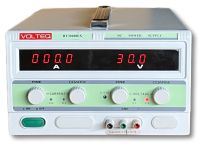FAQs on Electroplating and Electrolysis Rectifiers
How do DC power supplies contribute to the electroplating and electrolysis processes?
DC power supplies (or rectifiers) are essential components in electroplating, electroforming and electrolysis processes, providing a stable and controlled DC output to drive the electrochemical reactions. The power supply converts AC power to DC power, which is used to deposit metal onto a substrate in electroplating and electroforming, or to drive the electrolysis process that separates a compound into its constituent elements.
What factors should be considered when selecting a DC power supply or rectifier for electroplating and electrolysis applications?
When selecting a rectifier for electroplating and electrolysis applications, the size and type of workpiece/electrode determines the current you need, which is the most important parameter you need to calculate and plan for. Most of plating applications are fairly tolerable about the ripple noise, in fact, ripple maybe beneficial for some plating applications. However, electrosis and precious metal electroplating typically demand lower ripple noise.
How do I determine the appropriate voltage and current ratings for my DC power supply or rectifier in electroplating and electrolysis processes?
To determine the appropriate maximum voltage and current ratings for your DC power supply or rectifier, consider the size of your workpiece and electrodes, the type of metal being plated or electrolyzed, and the desired thickness of the coating. Generally speaking, higher current densities result in faster deposition rates, and larger parts/electrodes demand higher total current. For most of immerse plating applications, one rarely needs voltage higher than 12V, while for electrolysis the voltage depends on the specific electrochemical reaction taking place and configuration of the cell.
What are the differences between constant voltage and constant current modes in DC power supplies or rectifiers, and which mode is more suitable for electroplating and electrolysis applications?
Constant voltage mode maintains a constant output voltage, while constant current mode maintains a constant output current. Constant voltage and constant current modes are both suitable for electroplating applications, where the thickness of the coating is controlled by the deposition rate and time. Constant current mode is more suitable for electrolysis applications, where the amount of material decomposed is proportional to the current passing through the electrolyte.
How can I optimize the efficiency and performance of my DC power supply or rectifier during electroplating and electrolysis processes?
To optimize the efficiency and performance of your DC power supply or rectifier during electroplating and electrolysis processes, ensure that the power supply is properly sized for your application, and built with the modern switching technologies (IGBT or SCR).
What are the common maintenance practices and safety precautions to follow when using DC power supplies or rectifiers in electroplating and electrolysis applications?
Common maintenance practices include regularly inspecting and cleaning cooling fans, checking for loose or corroded connections, and monitoring performance. Safety precautions involve using proper grounding, following manufacturer guidelines, and ensuring that personnel are trained in the safe operation and maintenance of the equipment.
What are the latest technological advancements and trends in DC power supplies or rectifiers for electroplating and electrolysis applications?
Latest technological advancements and trends in DC power supplies or rectifiers for electroplating and electrolysis applications include increased energy efficiency, improved control options, and enhanced safety features. These advancements benefit various applications by offering more precise control, reduced energy consumption, and better integration with other systems.

